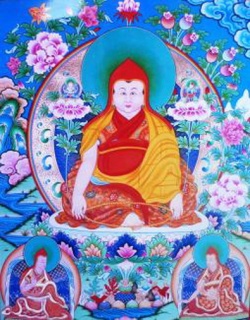Difference between revisions of "Yumo Mikyo Dorje"
Jump to navigation
Jump to search
(Created page with "Yumo Mikyo Dorje (Tibetan: ཡུ་མོ་མི་བསྐྱོད་རྡོ་རྗེ་, Wylie: Yu-mo Mi-bskyod Rdo-rje) was a student of the Kashmiri scholar Soma...") |
|||
| Line 1: | Line 1: | ||
| + | [[File:Dolpopa.2.teaser.JPG|thumb|250px|]] | ||
Yumo Mikyo Dorje (Tibetan: ཡུ་མོ་མི་བསྐྱོད་རྡོ་རྗེ་, Wylie: Yu-mo Mi-bskyod Rdo-rje) was a student of the Kashmiri scholar Somanatha, and an 11th century [[Kalachakra]] master. Yumo Mikyo Dorje is regarded as one of the earliest Tibetan articulators of a shentong ([[zhentong]]) view of [[shunyata]] — an understanding of the absolute radiant nature of reality. Emphasized within the [[Kalachakra Tantra]] and the [[Gautama Buddha|Buddha's]] teachings on [[Buddha nature]] in the so-called [[Three Turnings of the Wheel of Dharma|The Third Turning of Wheel]], this view later became emblematic of the [[Jonang]] tradition of [[Tibetan Buddhism]]. | Yumo Mikyo Dorje (Tibetan: ཡུ་མོ་མི་བསྐྱོད་རྡོ་རྗེ་, Wylie: Yu-mo Mi-bskyod Rdo-rje) was a student of the Kashmiri scholar Somanatha, and an 11th century [[Kalachakra]] master. Yumo Mikyo Dorje is regarded as one of the earliest Tibetan articulators of a shentong ([[zhentong]]) view of [[shunyata]] — an understanding of the absolute radiant nature of reality. Emphasized within the [[Kalachakra Tantra]] and the [[Gautama Buddha|Buddha's]] teachings on [[Buddha nature]] in the so-called [[Three Turnings of the Wheel of Dharma|The Third Turning of Wheel]], this view later became emblematic of the [[Jonang]] tradition of [[Tibetan Buddhism]]. | ||
Revision as of 13:12, 23 January 2013
Yumo Mikyo Dorje (Tibetan: ཡུ་མོ་མི་བསྐྱོད་རྡོ་རྗེ་, Wylie: Yu-mo Mi-bskyod Rdo-rje) was a student of the Kashmiri scholar Somanatha, and an 11th century Kalachakra master. Yumo Mikyo Dorje is regarded as one of the earliest Tibetan articulators of a shentong (zhentong) view of shunyata — an understanding of the absolute radiant nature of reality. Emphasized within the Kalachakra Tantra and the Buddha's teachings on Buddha nature in the so-called The Third Turning of Wheel, this view later became emblematic of the Jonang tradition of Tibetan Buddhism.
